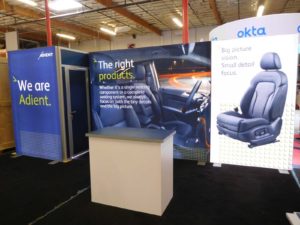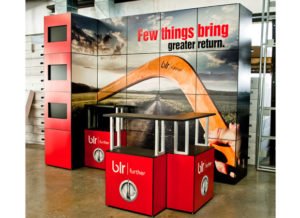Trade Shows: Using Photography In Your Exhibit
Leveraging the trade show environment with photography in your exhibit can have positive and negative results. Why?
They may seem like two very different things: the “live” environment of the trade show and the “static” aspect of photography.
You might thing they shouldn’t mix, but there are proven ways to use photography in your exhibit. These approaches can help you attract attention and communicate your message. You’ll also build rapport with visitors to your booth. It’s all in how you use photography at the show.
Here are some ideas on how to make it work:
1) Focus on the “live” factor:
Place the photos on the back wall of your exhibit. At the entrance, place booth staffers who are naturally outgoing. They can attract attention and initiate conversations with passersby. Staffers can use the photos to explain your product or service. Just don’t expect the photography in your exhibit to do the work for you.
2) Focus on one or two images:
Think of photography in your exhibit like a billboard. Use an image (or two) that “hits hard” in that brief moment you have to capture someone’s attention. Just the way a billboard does on a highway.
You might use two images to demonstrate a “before” and “after.” But however many you use, be sure they make a considerable impact.
3) Focus on movement:
If you plan to use more than a couple of pictures, consider creating a slide show to run on a monitor in your booth. Even that little bit of movement as the pictures change is more eye-catching than static photos. And there’s no reason not to include video in among those still images, too.
4) Focus on your customers:
All the photography in your exhibit doesn’t have to showcase your product. The images can also present your customers or even booth visitors.
There’s a big trend now to use a photo booth into your exhibit, so you can take pictures during the show. Using a green screen, you can superimpose your visitors onto a Hollywood red carpet or a magazine cover.
You could also do something clever, like posing your visitors as workers in your plant. With the green screen, you could merge their image with a picture of equipment in your factory. Voila! They’re actually using your product in the photo – and if you use social media to send their pictures to them, you’ll boost the fun, and leverage the impact for your booth traffic!
5) Focus on your products:
If you’re going to use pictures of your product (instead of the product itself), there should be a valid reason. For example, if your product is too big to fit in your exhibit or too small to be seen from the aisle, a photo can help tell your story.
But don’t limit yourself to glamour shots of your product, just sitting there. Make the photos more interesting by showing the product in use, allowing booth visitors to see what the product does, and how it could help them.
6) Focus on the folks back home:
You’ll want to use photography in your exhibit to document your display, from one show to the next. If all you need is a shot that shows what your booth looks like, working with the show photographer is generally your best bet.
They’re accustomed to working at trade shows, they bring the equipment they need, and you’ll get professional-quality prints. But, the show photographer usually has dozens of exhibits to shoot. So you won’t get too much time with them, and you probably won’t get anything too artistic.
To get the best of both worlds, consider hiring an outside photographer. He or she will have the time and skills to capture your exhibit exactly the way you want it.
I spoke with David Marquardt, a trade show exhibit photographer based in Las Vegas. He had these suggestions for getting the best results from using an outside service like his:
“You’ll want to get the shots that document what your booth looks like, so you can show people at the home office what you’ve done at past shows.
“But don’t just get shots of an empty booth. Get pictures of your staff, and those staff people interacting with visitors. A photo of a live presentation or product demo in progress is great. Or a booth staffer sharing a laugh with a customer or writing an order. These kinds of images convey warmth, humor and the human contact that’s the most unique aspect of the trade show environment.”
7) Focus on the future:
Your use of photos doesn’t have to be limited to what’s going on in the booth itself. There are several ways to get more mileage out of pictures taken at the show. Uploading them to sites like Twitter, Facebook and Instagram allows you to share the experience with people who may not have been able to visit the show. This also stretches the usefulness of those images after the show is over.
Also consider webcasting, to stream images of your exhibit to your website. Your product demo, executive keynote, interview with a booth visitor, and even your prize drawings can be shared online.
Don’t lose focus on your exhibit. If your current display isn’t properly highlighting the photography in your exhibit, it may be time to create something new. We’d love to help. From a portable display to a larger modular exhibit, American Image Displays can give you just what you need to attract attention, communicate with visitors and increase memorability. We also offer a wide range of exhibiting accessories, including literature racks, lighting and display kiosks. To learn more, call (800) -676-3976 or email [email protected].


